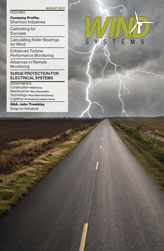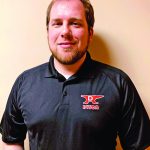I’m impressed by the extent to which Snap-on is specifically addressing the needs of the wind industry.
In this position, 100 percent of my time is committed to helping wind professionals meet the challenges they face through the use of our hand tools, torque products, and productivity solutions. I do that by visiting wind facilities, climbing turbines, asking informed questions, and offering solutions. This process is part of our company DNA, in fact. Joseph Johnson and William Seidemann developed sockets that would “snap on” to interchangeable handles, and formed the Snap-on Wrench Company back in 1920. They later pioneered taking the tools directly to customers to demonstrate their benefits, and that direct interface really became the cornerstone of our philosophy. It’s also true that, being around for nearly a century, we’ve amassed a significant amount of knowledge that we’re able to share with our wind customers while modifying our approach and our products to meet their requirements.
For example, we work closely with major wind OEMs and have developed a special ergonomic, ratcheting, tetherable hub-hatch tool solution for GE and Vestas turbines. In addition, we regularly see modification of hand and power tools due to turbine space constraints. In these cases we explain that it’s not advised to alter the tool’s original properties and show how we can design and manufacture custom tools that meet industry standards. Safety and performance are among our main priorities, and the more information we can gather about specific applications, the greater value we can provide.
Talk more about how you have managed to achieve this level of interaction.
Snap-on Industrial has more than 200 engineers on staff dedicated to innovative tool and instrument design, and over 300 dedicated industrial representatives in the United States that we refer to as “solutioneers.” Our account managers are tool experts, and when they visit a facility they’re able to discuss details as opposed to just part numbers. They ask questions about how a tool is being used so we can help customers choose the right tool for the job. That’s especially important in the wind industry, because you don’t want to climb 300 feet uptower only to find you don’t have the right tools on hand. There’s a direct line between productivity and having the proper tools for the job right from the start.
The wind industry is at a point in its evolution where concepts such as tool management, standards, and certification are taking hold. Tool management can be applied to technician kits, truck kits, or construction trailers. For instance, when large containers come back from sites they’re often in complete disarray, with many tools missing. We developed a barcode-based software system for the military that basically matches a tool with a user when he or she checks it out, so you have a record not only of who has a tool but where they are in case you need it. This system can also track calibration requirements, so that a reminder pops up before someone takes tools and instruments out on a new job. Plus, when people are accountable for the tools they tend to return them, and that can save tens of thousands of dollars refitting one container alone.
We also offer training in tool safety, and the proper and safe use of torque wrenches. In addition, we developed a “Tools at Height” tethered tool system to reduce the potential for injury and component damage resulting from dropped tools. With regard to the development of standards, I sit on two AWEA committees — End of Warranty, and Generator—and Snap-on is a key industry partner with NC3, or the National Coalition of Certification Centers, which is a collaboration between education and industry to develop portable training certifications across the energy, aviation, and transportation markets. We need to remember that wind technicians and other workers throughout North America are coming from varied backgrounds, and certifications have proven over the years to be powerful as a means of assuring employers that their new hires are properly trained.
I can see how your customers would benefit from being affiliated with a company like Snap-on Industrial.
We’ve been around for 91 years and have seven manufacturing facilities in the United States alone. Snap-on was founded on innovation, which means we’re accustomed to adapting to emerging markets like the wind industry. We deliver value by sharing the knowledge gained over decades of work in other markets like traditional power generation, aviation, railroads, and nuclear, just to name a few. This is the kind of relationship that benefits everyone involved.
To learn more: Call (413) 519-3380, e-mail john.r.tremblay@snapon.com, or go online to www.snapon.com/industrial.








































